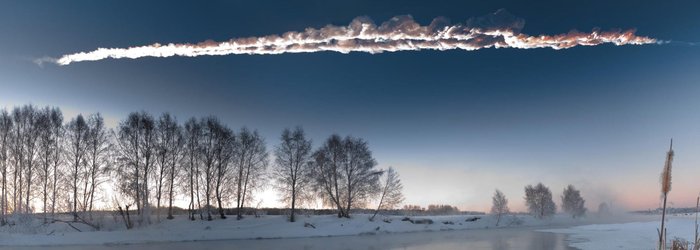5th anniversary of Chelyabinsk event, the biggest asteroid airburst since 1908

February 15, 2018 marks the 5th anniversary of the Chelyabinsk event, the biggest asteroid airburst this century so far and the biggest one since the 1908 Tunguska event. This is also the only asteroid confirmed to have resulted in a large number of injuries.
The asteroid exploded some 29.7 km (18.5 miles) above the Russian city of Chelyabinsk at 09:20 YEKT (03:20 UTC) on February 15, 2013, damaging over 3 000 buildings and injuring over 1 500 people (mostly by broken window glass).
Although it was just about 20 m (65 feet), its light was brighter than the Sun and visible up to 100 km (62 miles) away.
Chelyabinsk asteroid, officially named Chelyabinsk meteorite, was undetected before its atmospheric entry, in part because its radiant was close to the Sun.

Check your speakers. Loud asteroid explosion on video.
This is how the object looked like from space:
This is what the #Chelyabinsk meteor looked like from space 5 years ago #Today [EUMETSAT METEOSAT-10 animation] https://t.co/1564dDtJuQ pic.twitter.com/RsDSO9RIQ8
— Massimo (@Rainmaker1973) February 15, 2018
This what the #Chelyabinsk meteor’s plume looked like from space 5 years ago #Today [Japanese MTSAT-2 satellite] https://t.co/gKQtAT0IUy pic.twitter.com/cuzGFs2oCI
— Massimo (@Rainmaker1973) February 15, 2018
Five years ago today a meteor entered the Earth’s atmosphere and exploded over the Russian town of #Chelyabinsk.
Here’s how it looked from one of @eumetsat‘s weather satellites. pic.twitter.com/nslwI23HDK
— Simon Proud (@simon_sat) February 15, 2018
In the hours following the visual meteor sighting, a 6-meter (20 feet) wide hole was discovered on Lake Chebarkul’s frozen surface and scientists from the Ural Federal University collected 53 samples from around the hole the same day it was discovered.
A large number of small meteorites fell on areas west of Chelyabinsk and local residents and schoolchildren located and picked up some of them by following visible holes left in the outer surface of the snow.


In June 2013, Russian scientists reported that further investigation by magnetic imaging below the location of the ice hole in Lake Chebarkul had identified a 60 cm (2 feet) wide meteorite buried in the mud at the bottom of the lake. Following an operation lasting a number of weeks, it was raised from the bottom on October 16, 2013. With a total mass of 654 kg (1 442 lb), this is the largest found fragment of the Chelyabinsk meteorite.
In November 2013, a video from a security camera was released showing the impact of the fragment at the Chebarkul Lake. From the measured time difference between the shadow generating meteor to the moment of impact, scientists calculated that this meteorite hit the ice at about 225 meters per second, 64 percent of the speed of sound.
This is the first recorded impact of a meteorite on video. You can see it below:


Video shows the first recorded impact of a meteorite. Chelyabinsk, Russia February 15, 2013
Featured image: Vapour cloud trail left by Chelyabinsk asteroid on February 15, 2014. Copyright M. Ahmetvaleev

Commenting rules and guidelines
We value the thoughts and opinions of our readers and welcome healthy discussions on our website. In order to maintain a respectful and positive community, we ask that all commenters follow these rules:
We reserve the right to remove any comments that violate these rules. By commenting on our website, you agree to abide by these guidelines. Thank you for helping to create a positive and welcoming environment for all.